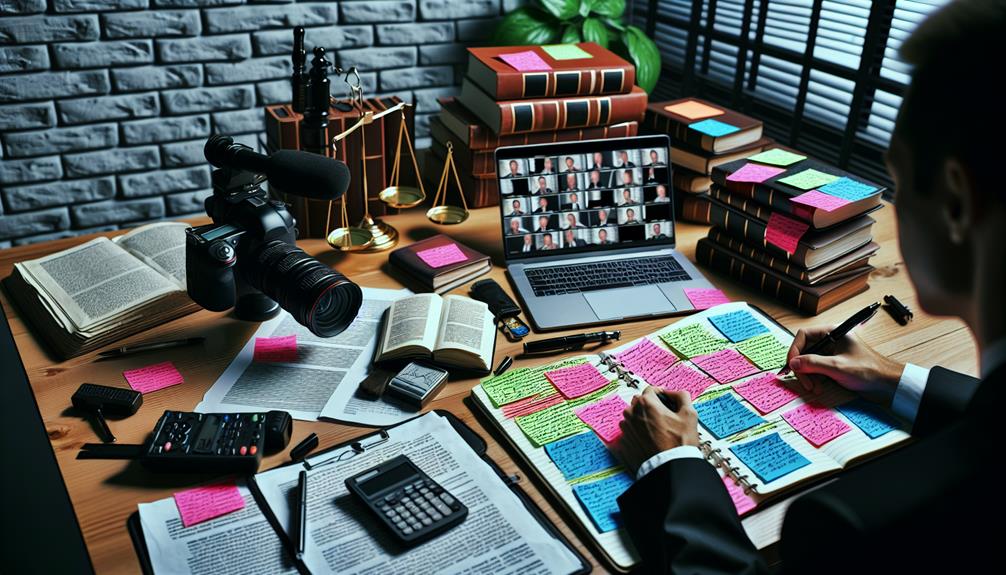As I sit down at my desk, a blank screen staring back at me, I can't help but think about the importance of effective video deposition preparation. It's like laying the foundation for a solid case, ensuring every detail is meticulously examined and presented.
The truth is, video depositions have become an integral part of the legal process, and mastering the art of preparation can make all the difference. So, what are the top 10 tips that can help you navigate this terrain with confidence and finesse?
Well, you're about to find out.
Key Takeaways
- Dress appropriately and choose a quiet location for the video deposition.
- Test equipment beforehand and familiarize yourself with the technology.
- Review the case and relevant documents to be well-prepared.
- Focus on body language, voice modulation, and active listening skills during the delivery.
Dress Appropriately

When preparing for a video deposition, it's crucial to dress appropriately to make a professional and credible impression. Your attire speaks volumes about your professionalism and can greatly impact how you're perceived by others.
To ensure a successful video deposition, it's important to pay attention to your appearance and dress in appropriate attire.
First and foremost, it's essential to dress in a manner that's suitable for the legal setting. This means avoiding overly casual or flashy outfits and opting for more conservative and professional attire. A well-fitted suit or dress, in solid colors or subtle patterns, is always a safe choice. It conveys a sense of seriousness and professionalism, which is crucial in a legal setting.
Moreover, it's important to remember that appearance matters not only for the benefit of the opposing counsel and the judge but also for the jury. The way you present yourself can influence their perception of your credibility and the strength of your arguments.
Choose a Quiet Location
Choosing a quiet location is crucial when preparing for a video deposition to ensure clarity of communication and minimize distractions. The noise in the background can interfere with the audio quality, making it difficult for both parties to understand each other. To create a conducive environment, find a room where there's minimal external noise, such as traffic, construction, or loud neighbors.
A quiet location not only benefits the audio quality but also enhances the overall video quality. Background noise can be distracting, and it may take away from the focus on the deposition itself. By choosing a quiet location, you can ensure that the video remains professional and polished, allowing the viewers to concentrate on the content rather than being distracted by any unnecessary noise.
To select the ideal quiet location, consider factors such as the time of day when there's less activity or noise in the area. Additionally, close any windows or doors to minimize external sounds. If necessary, use soundproofing materials or equipment to further reduce any unwanted noise.
Test Your Equipment Beforehand
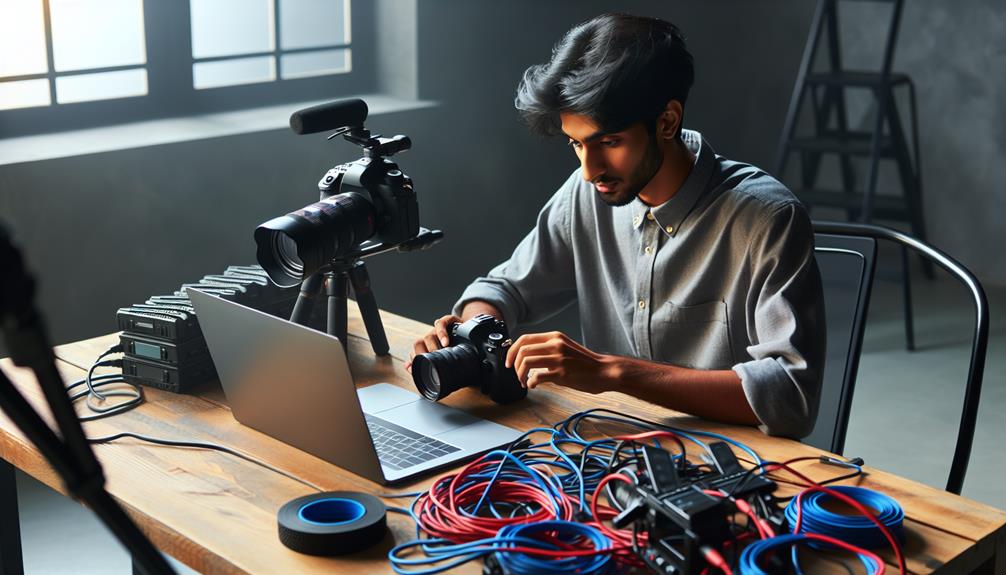
Before proceeding with your video deposition, it's essential to test your equipment beforehand to ensure smooth and uninterrupted proceedings. Equipment testing is crucial because it allows you to identify any potential issues and make necessary adjustments before the actual deposition takes place.
One aspect that you should pay close attention to during equipment testing is the audio quality. Poor audio can significantly impact the effectiveness of your video deposition. It can lead to misunderstandings, difficulty in capturing accurate testimony, and even legal consequences. Therefore, take the time to test your microphones, speakers, and recording devices to ensure that the audio is clear and easily understandable.
To test the audio quality, consider using a variety of scenarios that may occur during the deposition. For example, simulate different distances between the participants and the microphones, as well as speaking volumes. This will help you identify any issues like background noise, echoes, or muffled voices. Adjust the microphone positions and audio settings accordingly to optimize the audio quality.
In addition to audio, it's also essential to test other equipment such as cameras, lighting, and internet connectivity. Ensure that the cameras are positioned correctly to capture all participants clearly. Check the lighting conditions to avoid shadows or overly bright spots. Test the internet connection to ensure a stable and uninterrupted video streaming experience.
Familiarize Yourself With the Technology
Now that you have tested your equipment and ensured the audio quality is clear, it's time to familiarize yourself with the technology for your video deposition. Technology familiarity is crucial to ensure a smooth and effective deposition process. Understanding the ins and outs of the equipment and software won't only save you time but also help you present your case in the best possible way.
Start by familiarizing yourself with the video conferencing platform you'll be using. Take some time to explore its features and understand how to navigate through the interface. This will help you feel more confident during the deposition and prevent any technical hiccups.
Additionally, it's important to be aware of video deposition etiquette. Make sure you understand how to mute and unmute yourself, as well as how to share your screen if needed. Familiarize yourself with the process of admitting exhibits and sharing documents electronically. Being well-versed in these aspects of the technology will help you maintain professionalism and avoid any unnecessary disruptions.
Prepare an Outline or Script
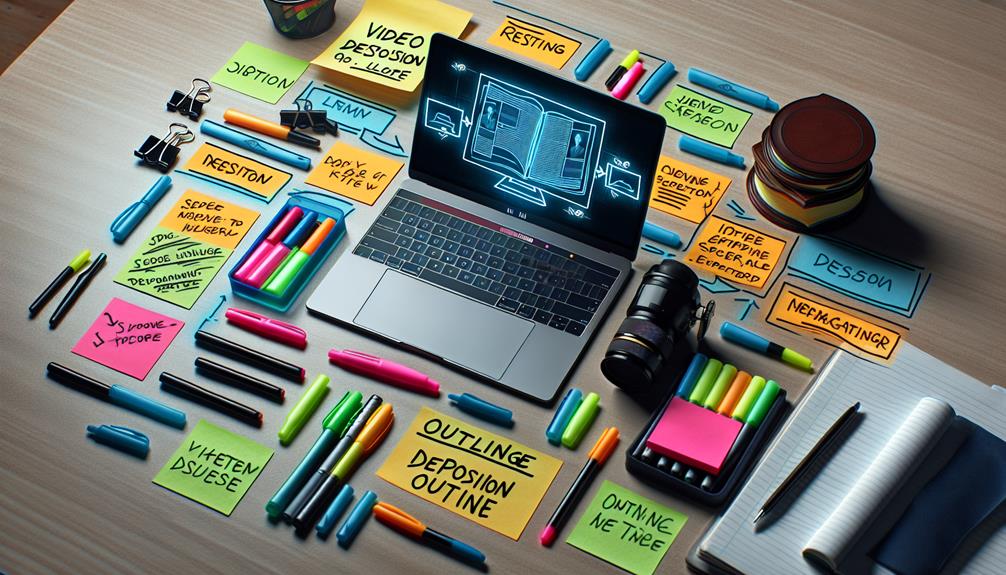
When it comes to video depositions, preparing an outline or script is crucial. It helps me to organize my thoughts and ensures that I cover all the necessary points.
Outline or Script Importance
Creating an outline or script for your video deposition is crucial for effective preparation. The outline serves as a roadmap, guiding you through the deposition process and ensuring that you cover all the necessary topics. It helps you organize your thoughts and present your case in a clear and logical manner.
Having a script can enhance your effectiveness during the deposition. It allows you to carefully plan and craft your responses, ensuring that you deliver your message effectively. A well-prepared script helps you stay focused and prevents you from getting sidetracked or forgetting important points.
Structuring Your Content
Having a well-structured outline or script is essential for effectively preparing for your video deposition and ensuring that you present your content in a clear and compelling manner. When structuring your content, it's important to think about the key points you want to address and the order in which you'll present them.
Start by introducing your main argument or thesis, and then provide supporting evidence and examples to back it up. Use headings and subheadings to organize your thoughts and make it easier for the viewer to follow along.
Additionally, consider including transitions between different sections to help guide the flow of your presentation. By taking the time to structure your content, you'll be able to deliver a more coherent and persuasive video deposition that effectively communicates your message.
Maximizing Deposition Effectiveness
To maximize the effectiveness of your deposition, I recommend preparing a well-structured outline or script. A clear and organized outline helps you stay focused and ensures that you cover all the necessary points during the video deposition. It serves as a roadmap, allowing you to navigate through the deposition smoothly and efficiently.
Your outline should include key questions, topics, and supporting evidence that you want to address. Additionally, consider preparing a script for your opening and closing statements. This will help you deliver a powerful and persuasive message while maintaining a professional demeanor.
Practice Your Delivery
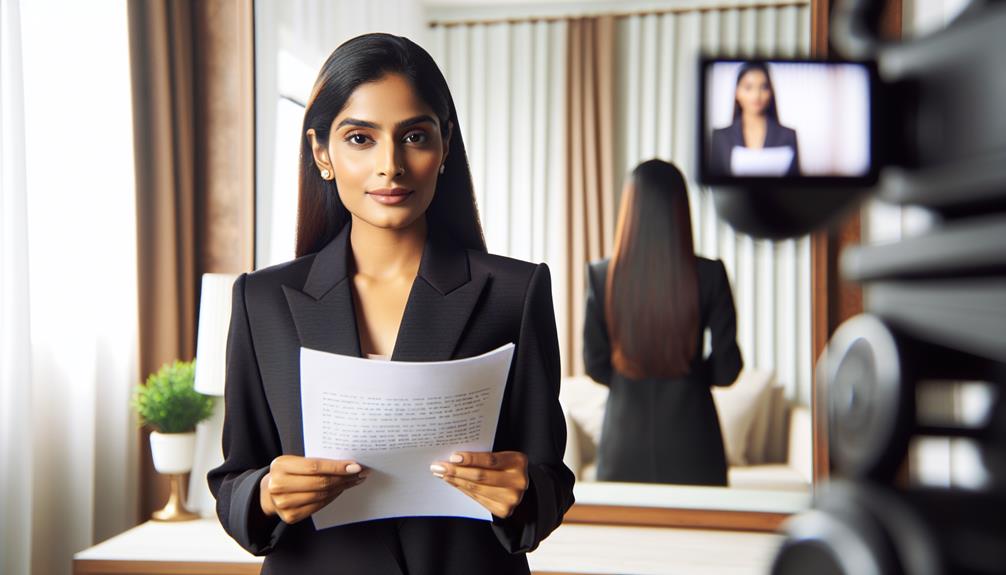
When it comes to giving a video deposition, your delivery is crucial. How you convey your information can greatly impact how it's received by the opposing counsel and the jury.
To ensure you're effectively communicating your points, it's important to practice your delivery techniques, rehearse your testimony, and work on your timing. By doing so, you can gain confidence in your presentation and make a strong impression during your video deposition.
Delivery Techniques
Practicing your delivery is crucial for a compelling and effective video deposition. Delivery techniques play a significant role in conveying your message and maintaining effective communication.
To ensure a captivating delivery, there are a few key aspects to focus on. First, pay attention to your body language. Maintain good posture, use appropriate gestures, and make eye contact with the camera.
Second, work on your voice modulation. Vary your tone, volume, and speed to keep the viewer engaged.
Third, practice active listening skills. Responding appropriately and thoughtfully to questions shows attentiveness and enhances your credibility.
Fourth, use visual aids strategically to support your statements.
Finally, rehearse your delivery several times to build confidence and eliminate any potential stumbling blocks.
Rehearsing and Timing
Now let's focus on perfecting your delivery by rehearsing and timing your video deposition.
Effective rehearsing techniques are key to delivering a compelling and impactful deposition. Start by practicing your opening statement to ensure a strong and confident start. Pay attention to your body language, tone of voice, and facial expressions to convey credibility and professionalism.
Rehearse answering potential questions, anticipating objections, and presenting evidence smoothly. Time management is crucial during a video deposition. Practice speaking at a steady pace to avoid rushing or speaking too slowly. Use a timer to ensure your responses are concise and within the allocated time.
Consider Body Language and Facial Expressions
My body language and facial expressions play a crucial role in conveying my message during a video deposition. While the words I choose are important, how I present myself physically can have an even greater impact on how my message is received.
Body language and facial expressions can either enhance or undermine the credibility of my testimony, so it's vital that I pay attention to these nonverbal cues.
First and foremost, maintaining good posture is essential. Sitting up straight and leaning slightly forward shows attentiveness and engagement. Slouching or leaning back can give the impression of disinterest or lack of confidence.
Additionally, making eye contact with the camera demonstrates sincerity and connection with the audience on the other end.
Furthermore, being mindful of my facial expressions is crucial. A genuine smile can help to establish rapport and put the viewer at ease. On the other hand, frowning or appearing visibly frustrated may give the impression that I'm being evasive or defensive.
Review the Case and Relevant Documents
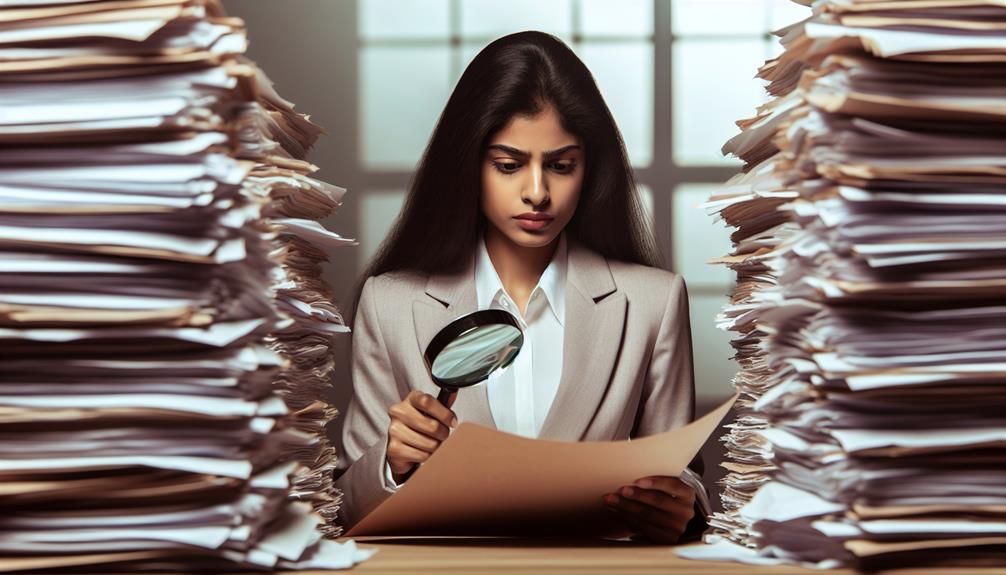
With a solid understanding of how body language and facial expressions can impact the credibility of my testimony, it's crucial to now shift our focus towards thoroughly reviewing the case and relevant documents.
A comprehensive case review and document analysis is essential to ensure that I've a deep understanding of the facts, evidence, and legal issues surrounding the case. By carefully examining the case materials, such as pleadings, motions, and witness statements, I can identify key points, inconsistencies, and potential areas of weakness or strength. This thorough preparation will allow me to anticipate opposing counsel's arguments and effectively respond during the deposition.
During the case review, it's important to pay attention to any legal precedents, statutes, or regulations that may be relevant to the case. Understanding the legal framework will help me provide more nuanced and informed answers during the deposition.
Additionally, analyzing the documents will enable me to identify any missing or incomplete information that may require further investigation or clarification.
Anticipate and Prepare for Objections
When it comes to video depositions, it's crucial to anticipate and prepare for objections that may arise during the questioning process. As a legal professional, I've found that objection handling techniques are essential to maintaining the flow of the deposition and ensuring that the witness's testimony is accurately recorded.
Additionally, preparing the witness for potential objections can help them feel more confident and prepared, allowing them to provide clearer and more consistent answers.
Objection Handling Techniques
Anticipating and preparing for objections is a crucial skill when it comes to effective objection handling techniques in video depositions. By being proactive and considering potential objections beforehand, you can better navigate the deposition process and maintain effective communication.
One key strategy is to familiarize yourself with the case facts and anticipate the opposing counsel's arguments. This allows you to prepare solid counterarguments and evidence to support your position.
Additionally, it's important to remain calm and composed during objections. Take a moment to gather your thoughts before responding and stay focused on the main points of your testimony.
Preparing Witness for Objections
To effectively prepare a witness for objections during video depositions, it's crucial to anticipate and address potential challenges in advance. Witness coaching plays a vital role in ensuring that the witness is well-prepared to handle objections effectively and confidently.
One key strategy is to familiarize the witness with common objections that may arise, such as hearsay or leading questions. By providing the witness with objection strategies, they can respond appropriately and maintain their credibility.
It's also essential to coach the witness on remaining calm and composed when faced with objections, as this will help them stay focused and articulate their responses clearly.
Take Breaks and Stay Focused
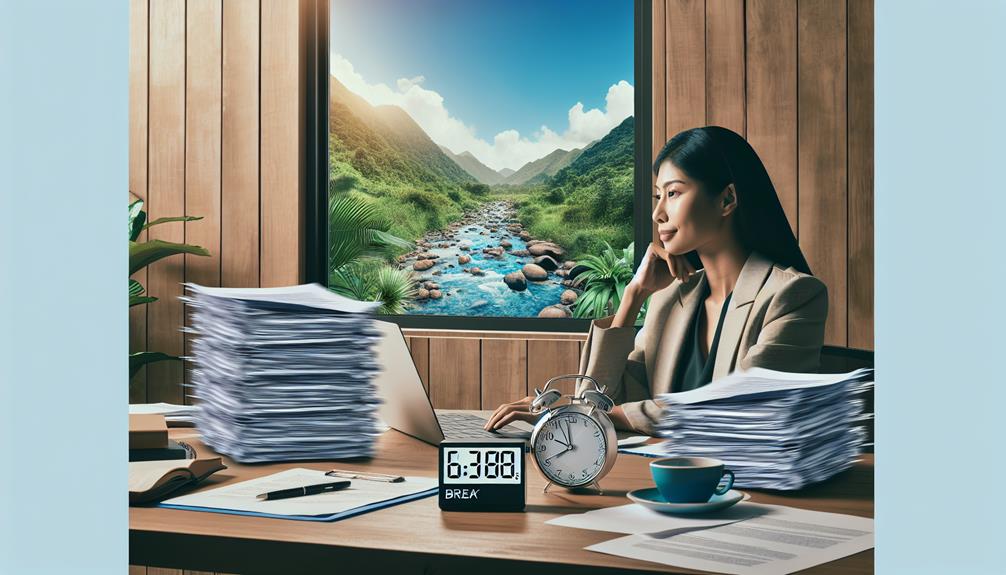
Taking regular breaks and maintaining focus are essential for effective video deposition preparation. In the fast-paced world we live in, it's easy to become overwhelmed and lose concentration. By incorporating breaks into your preparation routine, you can stay alert and manage distractions more effectively.
When I prepare for video depositions, I find that taking short breaks every hour or so helps me recharge and refocus. During these breaks, I step away from my computer screen and engage in activities that relax my mind, such as going for a walk or practicing deep breathing exercises. These breaks not only give my brain a chance to rest, but they also prevent me from becoming too fatigued and losing productivity.
Additionally, staying focused during video deposition preparation is crucial. With the constant influx of information and distractions, it's easy to get sidetracked and lose valuable time. To combat this, I make sure to create a dedicated workspace that's free from distractions, such as turning off notifications on my phone and closing unnecessary tabs on my computer.
Conclusion
In conclusion, effective video deposition preparation is crucial for a successful deposition. By following these top 10 tips, you can ensure a smooth and professional deposition experience:
- Dress appropriately
- Choose a quiet location
- Familiarize yourself with the technology
Remember to review the case, prepare for objections, and take breaks to stay focused. With proper preparation, you can confidently present your case and achieve your desired outcome.

